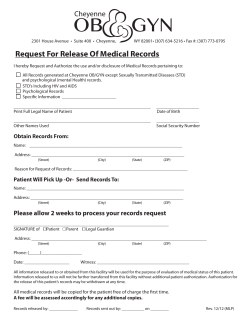
Gaining Control of Your Measurement Process Using PolyWorks®
Gaining Control of Your Measurement Process Using PolyWorks® www.mvsgroup.com Discussion Topics Motivation Extracting a Measured Primitive A Computer Experiment Experimental Results Conclusions and Recommendations Questions… 2 MOTIVATION… 3 Source: Downloaded from: http://westlife.northcoastnow.com/mccall-bursts-on-scene-for-north-ridgeville/NR-footbal-McCall.jpg, Sept. 8, 2013 Source: Convergence, 1952 by Jackson Pollock Downloaded from: http://www.jackson-pollock.org/convergence.jsp Upon further reflection… “With great power comes great responsibility.” – Stan Lee …or was it Spiderman’s Uncle Ben?... CREATING A MEASURED PRIMITIVE 9 Extracting a Measured Primitive 1. Collect Data Points 2. Filter the Data Points 3. Fit the Data Points 10 COLLECT – Fit Zone Max Distance to Nominal Primitive… RAW DATA LARGE DISTANCE TO NOMINAL PRIMITIVE RESULT OF “MAX” FIT 12 COLLECT – Fit Zone Max Distance to Nominal Primitive… LARGE DISTANCE TO NOMINAL PRIMITIVE RAW DATA RESULT OF “BEST” FIT 13 COLLECT – Fit Zone Max Distance to Nominal Primitive… RAW DATA SMALL DISTANCE TO NOMINAL PRIMITIVE 14 COLLECT – Large Deviation to Nominal Primitive Search Distance Anything suspicious here? 15 COLLECT – Boundary Exclusion Distance LOW BOUNDARY EXCLUSION HIGH BOUNDARY EXCLUSION 16 FILTER – Subsampling Step Computing GD&T Measurements… 18 FILTER – Max Angle 19 FILTER – Reject Outliers Empirical Rule: – 68% within 1σ – 95.5% within 2σ – 99.73% within 3σ Outside Std Dev Factor 100% = 64,283 Percentage of Points Filter at 1σ = 43,097 (or about 67%) 20 A COMPUTER EXPERIMENT 22 Computer Experiment Computers are deterministic – replications not required 4 different subjects (the minions…) 100 runs per subject – 50 using “Best-Fit” – 50 using “Max Fit” Modeled 16 different parameters – 9 continuous variables – 5 binary variables – 2 categorical variables 23 The Subjects 1. cylinder with form error but essentially at nominal 2. same cylinder with rotation error introduced 3. same cylinder with location error introduced (no rotation) 4. same cylinder with both location rotation error – not the same errors as above 24 Parameter Possible Values Default Values Experimental Values greater than 0 On/Off greater than 0 greater than 0 4mm Off 4mm 0.5mm .5mm to 6mm On/Off 1mm to 8mm 0 to 5mm On/Off greater than 0 On/Off 0 to 180 On/Off 0 to 100% Off 1 On 15 degrees On 2.5 sigma (~98.75%) On/Off 0, 0.2, 0.5, 1, 2mm On/Off* 0 to 180 On/Off* 0 to 31.73% "Best-Fit", "Min", "Max" On/Off On/Off greater than 0 0 to 180 degrees greater than 0 "Best-fit" Off Off 1mm 15 degrees 50% of radius "Best-Fit", "Max" On/Off On/Off 6mm 0 to 180 degrees 0 to 100% of radius Collect: Fit Zone Large deviation to nominal primitive Large deviation to nominal primitive - Search Distance Boundary Exclusion Distance Filter: Subsampling Step Subsampling Step Max Angle Max Angle Reject Outliers Reject Outliers Fit: Fit Type Constraining plane Constraint Radius Constraint Radius Size Min/Max Fit - Max Angle Deviation Min/Max Fit - Max Positional Deviation Latin Hypercube Sampling 180- 6 mm - 0.5 mm - 0- 3.25 mm - 90- Experiment Macro Approximately 100 lines of code Read text files containing parameter values from MINITAB® Same 50 runs were repeated 8 times – a single run consisted of unique values for 16 different parameters Wrote text files of the results using array variables into directory to be read back into MINITAB® for analysis EXPERIMENTAL RESULTS 29 BAD FORM DEFAULT FIT STD DEV: 0.310 MANUAL FIT STD DEV: 0.341 DEFAULT MANUAL ROTATED DEFAULT FIT STD DEV: 0.270 MANUAL FIT STD DEV: 0.341 DEFAULT MANUAL OFF LOCATION DEFAULT FIT STD DEV: 0.280 MANUAL FIT STD DEV: 0.341 DEFAULT MANUAL OFF LOCATION AND ROTATED DEFAULT FIT STD DEV: 0.343 MANUAL FIT STD DEV: 0.341 DEFAULT MANUAL 6 5 4 3 2 1 0 Fit Type SAMPLE BEST MAX 1_BAD FORM BEST MAX 2_ROTATED BEST MAX 3_LOCATION BEST MAX 4_LOC_ROT 6 5 4 3 2 1 0 Planar Const Fit Type SAMPLE 0 1 0 1 BEST MAX 1_BAD FORM 0 1 0 1 BEST MAX 2_ROTATED 0 1 0 1 BEST MAX 3_LOCATION 0 1 0 1 BEST MAX 4_LOC_ROT CONCLUSIONS AND RECOMMENDATIONS 37 Visual Interrogation of Measured Data Points Select >> Data Points >> Measured Data Points Ctrl+M Other Recommendations Consider creating alignments for each individual “problem” feature – Select data points using feature primitive – “Best-Fit” using selected elements – May require 2 repetitions Use Large Deviation – ensure distance exceeds expected location variation of feature (at least exceeds tolerance zone) – ensure fit zone exceeds expected size, form, orientation variation of feature Use sensitivity analysis – Change parameter settings to see how much the results change Tools >> Macro Scripts >> Create Play Inspection Macro Script Thank You! Questions?
© Copyright 2025









